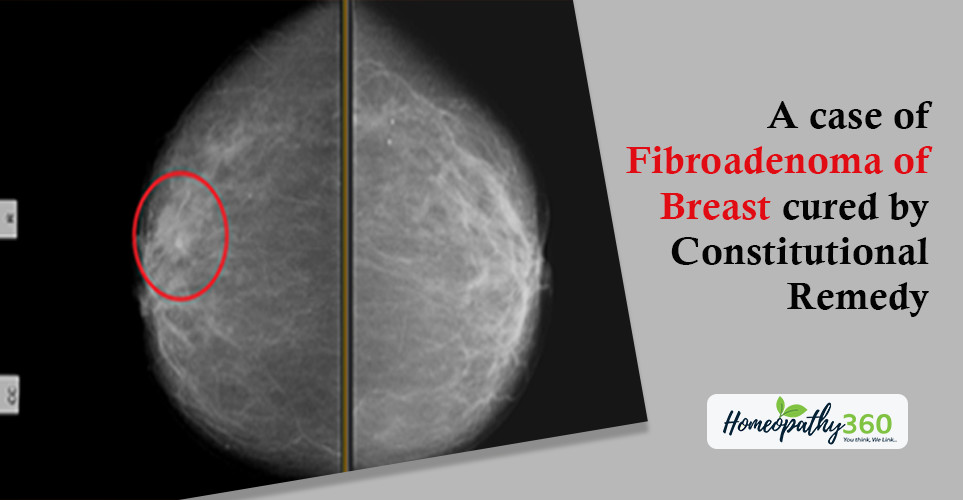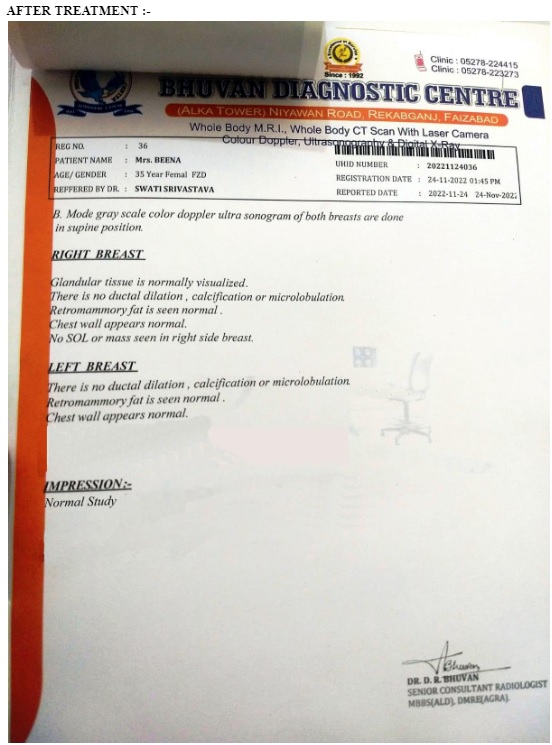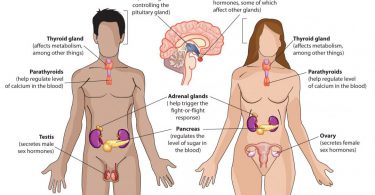
ABSTRACT: –
Fibroadenoma of the breast is a hormonal-related disease. Fibroadenoma is a non-cancerous breast tumor that most often occurs in young women. Reproductive hormones may cause fibroadenomas.
In this article, there is a case of a 36 years female who was suffering from fibroadenoma. She was treated within 5 months with a single constitutional homeopathic medicine sulphur 200, sac lac 30/tds.
Method – A detailed case taking was done and Fibroadenoma was diagnosed based on clinical examination, physical examination, and ultrasonography report.
A constitutional homeopathic remedy was prescribed based on complete symptoms with aid of repertorization.
Result– The patient recovered remarkably with homeopathic therapy.
KEYWORDS: – Constitutional homeopathic medicine, Fibroadenoma, sulphur, materia medica.
INTRODUCTION:-
The most common benign Tumor of the female breast is fibroadenoma. It is a new growth composed of both fibrous and glandular tissues.
AETIOLOGY-
This Tumor is said to develop as the result of increased sensitivity of a focal area of the breast to oestrogen. It is almost an accepted fact that there is some relationship between excess oestrogen levels and fibroadenoma. That is why this condition may present simultaneously with fibroadenomas. Pathology. These lesions are encapsulated and tend to be spherical but on occasion. they may be multinodular or somewhat irregular. The gross appearance is characteristic of smooth boundaries and the cut surface is glistening white. If the epithelial elements are excessive, they may appear as light brown areas. Fibroadenoma has mixed epithelial or glandular and mesenchymal elements. Fibroadenomas typically stop growing when they reach 2 to 3 cm in diameter. Blacks have a greater propensity than whites to develop fibroadenomas at a younger age. This lesion invariably has a relationship to oestrogen sensitivity and it occurs predominantly in the 2nd and 3rd decades of life.
Other variants of fibroadenoma are characterized by increased cellularity of the stroma and/or epithelium. These typically occur in adolescence and bear resemblance to benign phyllodes(leaf-like) tumors. The predominant carcinoma that presents concurrently with fibroadenoma is lobular carcinoma in situ. On section, these lesions are composed of uniform, greyish-white, fleshy, homogeneous masses with fibrous whorls which tend to bulge from the capsule. There may be some minute yellow to pink softer areas. Fibroadenoma is classified into two varieties according to their origins either Peri canalicular or Intracanalicular. The breast has two components of connective tissue separated by the elastic lamina which covers the ductulus. When the connective tissue outside this elastic lamina becomes proliferated along with the glandular element it is called peri canalicular fibroadenoma. When the connective tissue inside the elastic lamina becomes proliferated along with the glandular element, it is called intracanalicular fibroadenoma.
The PERICANALICULAR VARIETY (Hard fibroadenoma) is firmer, and smaller with an increase in ducts and fibrous stroma. This Tumor can be felt very clearly out of the breast tissue due to its tremendous firmness and it moves sufficiently within the breast substance, so it is often called a ‘breast mouse’. In this type round or oval gland, spaces are presently lined by single or multiple layers of cells.
The INTRACANALICULAR TYPE (Soft fibroadenoma) is relatively less firm, grows larger and the glandular tissue and the duct system are very much compressed with great distortion due to proliferated surrounding connective tissue pressing on them. Connective tissue is so profuse and rather loose that this type is often referred to as intraductal myxoma. It must be remembered that both peri canalicular and intracanalicular patterns may coexist within the same tumor.
CLINICAL FEATURES: –
(i) The peri canalicular or hard type usually occurs in younger girls between 15 and 30 years of age. Intracanalicular or soft fibroadenoma more commonly affects the older group from 30 to 50 years of age.
(ii) This tumor is most commonly presented as a painless, slowly growing, solitary Jump in the breast. While this tumor is often seen in the lower part of the breast, fibroadenomas occurs mostly in the upper and outer quadrants of the breast.
(iii) Multiple fibroadenomas may be present in about 10% of cases.
(iv) Pain is usually conspicuous by its absence, though it may occasionally be complained of, particularly when there is associated fibroadenosis.
(v) Though the hard variety is known for its slow growth and never attains a big size, yet intracanalicular fibroadenoma tends to be large in size due to rapid growth. Some discomfort or slight pain may be complained of due to its size rather than anything else.
(vi) Discharge through nipple is almost unknown.
LOCAL EXAMINATION-
INSPECTION does not reveal anything particular and the nipple remains always but in case of large intracanalicular fibroadenoma, swelling may be visible. normal.
PALPATION is important.
(a) Fibroadenomas are smooth or slightly tabulated usually measuring 2 to 3 cm in diameter. With the exception of those adjacent to the nipple, these are characteristically mobile. Mobility is more in young girls. Mobility lessens with increasing age due to the restraining effects of surrounding fibrotic tissue. In only 10% of cases there may be multiple fibroadenomas on presentation.
(b) A freely mobile solitary lump within the breast with a round smooth margin is nothing but a fibroadenoma. The consistency is firm, except in case of large intracanalicular variety when consistency may be softer.
(c) The lump is neither fixed to the overlying skin, nor fixed to the fascia covering pectoralis major. It is also not fixed within the breast and is so freely movable, that it is often called a breast mouse’.
(d) The axillary lymph nodes are usually not enlarged.
DIAGNOSIS: –
Up to the age of 25 years clinical diagnosis is enough. Mammography has no place in its routine diagnosis. With increasing age mammography and Fine Needle Aspiration Cytology (FNAC) should be performed to exclude malignancy.
Ultrasonography is quite helpful in the differential diagnosis of a palpable breast lump. Ultrasonography should preferably be done with Logic 500 Preserver having a linear multifrequency with a 6-9 MHz probe. A water pack is used for the examination of all breast lesions. The lesions should be viewed in both longitudinal and transverse planes employing low and high gain settings for the same transducer position. Each breast is examined quadrant by quadrant survey. If the mass is delineated, it is described as circumscribed or non-circumscribed.
Both benign and malignant lesions are detected by this technique. Confirmation of the diagnosis reached at ultrasonography is made by FNAC or histopathology.
It is a well-known fact that ultrasonography of the breast is very useful in differentiating cystic from solid masses. Well-circumscribed masses are mostly benign and poorly-circumscribed masses are mostly malignant. The accuracy of ultrasound in the detection of solid breast mass is about 65% in Indian studies and the cystic masses are correctly diagnosed in about 95% of cases.
Detection of carcinoma in breast by ultrasound is more accurate in western studies. However, in Indian studies benign lesions of the breast are more readily diagnosed by the ultrasound than malignant lesions. Sensitivity of ultrasound in the diagnosis of fibroadenoma of the breast is expected to be more than 80%.
TREATMENT
Excisional biopsy is the treatment of choice. Although a skilled clinician can probably detect a fibroadenoma with an accuracy of 80% to 85% of cases, excision is mandatory. This gives an opportunity to get the histopathological report. Moreover, removal of the tumour will give the patient a psychological advantage to have been cured of the disease. Peri areolar or sub mammary incision should be attempted at whenever possible for cosmetic reasons. As the tumour is often situated in the lower part of the breast, sub mammary incision (Gaillard Thomas’ incision) is often applied. Only when the tumour cannot be removed through one of these incisions, a radial incision or a curved incision along the line of Langer is made. The incision is deepened right up to the capsule of the tumour. In case of peri canalicular variety the capsule is incised and the tumour is removed with a finger which is pushed into the cleavage between the capsule and the tumour, the adhesions are severed and the tumour is brought out of the incision. This is called enucleation. In case of intracanalicular variety enucleation may not be possible and the whole tumour is excised. The dead space is obliterated with catgut suturing. Haemostasis is attained. The skin is closed. Drainage is only necessary when one is not very sure of haemostasis and when there is a big dead space.
It is better to send the excised tumour for frozen section biopsy. Only when, unfortunately, carcinoma is detected, quadrantectomy or Patay radical mastectomy should be performed according to the size of the tumour. The present trend is that in women under the age of 25 years, routine excision is unnecessary because of greater understanding of the natural history of this condition. If fibroadenomas are left untreated most will slowly increase in size up to 3 cm in diameter over a period of 5 years.
Thereafter they remain static or may gradually become smaller.[1]
CASE HISTORY: –
A case of a 36 years female suffering from fibroadenoma reported here was treated successfully within 6 months by a constitutional homeopathic medicine sulphur 200.
The improvement is relevant to the decrease of hair falling and also from ultrasonography (USG) reports.
History of present complaints: – The patient is suffering from fibroadenoma of the left breast which has been diagnosed on 24/06/2022 by ultrasonography. Tenderness of breast. The patient was suffering from hair fall for 2 months. Sometimes patients feel vertigo when shaking their head.
The patient was suffering from the sensation of heat on the vertex and pimples on the face. There is a burning sensation in the back region.The patient is suffering from copious menses and thin and acrid excoriating leucorrhoea after menses.
Physical generals: –
She had a good appetite but less thirst. She loved to eat spicy food. Her stool was changeable, sometimes normal, and sometimes hard. She had an aversion to oily fatty food which causes nausea. Her sleep was disturbed, and there was anxiety which causes sleeplessness. Thermally she was hot. There was burning during the micturition.
Menstrual history: – regular and copious menses, dark red.
Leucorrhoea: – After menses, acrid and excoriating and yellow colour.
Mental generals: – Suppressed anger, aversion to work, consolation aggravation, and patient is very impatient.
DIAGNOSIS: –
Diagnosis was based on clinical symptoms, physical examination of the patient and USG report.
CASE ANALYSIS AND EVALUATION OF SYMPTOMS: –
| S.No | TYPE OF SYMPTOMS | SYMPTOMS | INTENSITY | MIASMATIC ANALYSIS[2] |
| 1 | Physical General | Vertigo amelioration in open air | 3 | Psoric |
| 2 | Physical General | Vertigo aggravated by moving head | 2 | Psoric |
| 3 | Particular | Eruptions on head, pustules | 3 | Psoric |
| 4 | Physical General | Hair falling | 2 | Syphilitic |
| 5 | Particular | Heat sensation on vertex | 3 | Psoric |
| 6 | Particular | Pustules on extremities | 2 | Psoric |
| 7 | Physical general | Leucorrhoea cause itching | 3 | Sycotic |
| 8 | Physical general | Leucorrhoea after menses, leucorrhoea is thin and acrid and excoriating | 3 | syphilitic |
| 9 | Physical general | Profuse menses | 3 | Sycotic |
| 10 | Particular | Fibroadenoma of breast | 2 | sycotic |
REPERTORIAL TOTALITY[2]:-
| TOTALITY OF SYMPTOMS: – | RUBRICS |
| Vertigo amelioration in open air | [Vertigo]AIR,OPEN, IN Amelioration |
| Vertigo aggravated by moving head | [Vertigo]MOVING THE HEAD Quickly |
| Eruptions on head, pustules | [Head]ERUPTION: Suppurating |
| Hair falling | [Head]HAIR: Falling |
| Heat sensation on vertex | Head]HEAT: Vertex |
| Pustules on extremities | [Skin]ERUPTIONS: Pustules: |
| Leucorrhoea cause itching | [Genitalia female] ITCHING: Leucorrhoea, from: |
| Leucorrhoea after menses, leucorrhoea is thin and acrid and excoriating | [Genitalia female] LEUCORRHOEA: Acrid, excoriating: |
| Profuse menses | [Genitalia female] MENSES: Copious: |
| Fibroadenoma of breast | [Chest]TUMOURS: Mammae: |
REPERTORIZATION: –
This repertorization was done by Kent repertory by using ZOMEO software.[3]
REPERTORIAL ANALYSIS: –
- Sulphur—21/9
- Calcarea carb—-17/7
- Phosphorus –15/7
- Sepia —-15/6
- Kali carb —-13/7
SELECTION OF THE REMEDY AND POTENCY: – The reportorial result showed that sulphur covered maximum symptoms with the highest gradation. Therefore, an individualized single constitutional remedy, SULPHUR was selected based on the totality of symptoms covered in Materia medica Allen’s keynote[4] and boericke Materia medica[5]. All symptoms are covered by sulphur, although the patient was hot so here, I have prescribed sulphur 200 to the patient. The medicinal dose was only repeated when its action was ceased.[6]
Follow-up: –
After 5 months of regular treatment, the patient improved very much. She reported with USG. In USG, the fibroadenoma is cured.
| DATE | RESPONSE | PRESCRIPTION |
| 02/08/2022 | The pain of fibroadenoma and eruptions on face and scalp relieved | Rubrum met 200 /3dose Sac lac 30/tds |
| 23/08/2022 | Eruptions in extremities decreased, and vertigo episodes decreased. Hairfall improved. | Rubrum met 200 /3doseSac lac 30/tds |
| 06/09/2022 | leukorrhea became normal in consistency | Sulphur 200/3doseSac lac 30/TDS |
| 27/09/2022 | Improved. No vertigo at all. | Rubrum met 200 /3doseSac lac 30/TDS |
| 04/10/2022 | Improved in all complaints | Rubrum met 200 /3doseSac lac 30/tds |
| 25/10/2022 | Suffered from acute coryza with headache. | Sulphur 200 /3doseSac lac 30/TDS |
| 01/11/2022 | Improved | Rubrum met 200 /3doseSac lac 30/TDS |
| 15/11/2022 | No eruptions at all in her body, she was feeling good. | Rubrum met 200 /3doseSac lac 30/TDS |
| 29/11/2022 | Her sonography reports were normal, there was no growth of the breast in the form of fibroadenoma. | Rubrum met 200 /3doseSac lac 30/TDS |


DISCUSSION AND CONCLUSION: –
Studies in homeopathy have shown a positive role.
Hyperandrogenism and the effect of Lifestyle modification were not evaluated and statistical rigor was also lacking. Due consideration has been given to all these aspects while drafting this protocol. Despite the increasing incidence of this problem, limited research has been conducted that covers the full spectrum of fibroadenoma.
The patient was taking allopathic treatment and there was no relief so the patient came to my OPD SNHMC on the date 19/07/2022.
All symptoms are covered by sulphur, although the patient was hot so here, I have prescribed sulphur 200 to the patient. After prescribing medicine, patients have improved so much. Her vertigo and eruptions on body have decreased and her leucorrhoea has also improved.
Ultrasonography (USG) showed a normal result.
This patient was successfully cured and followed up regularly.
REFERENCES:-
- Das S. A concise textbook of surgery. 7th ed. Kolkata: Dr S Das publication; 2012.
- Babu NG, Comprehensive study of Organon, 1.1 ed. New Delhi: B. Jain publishers Ltd.:2009
- Zomeo Kent computer repertory Zomeo Elite Version 14.0.0 Copyright 2022 Mind Technologies Pvt. Ltd.
- Allen TIC, Allen’s Keynote Rearranged. & Classified, 10 ed. New Delhi: B. Jain Publishers (P) Ltd.; 2013.
- Boericke W. Boericke’s New Manual Of Homoeopathic Materia Medica & Repertory, LPE ed. New Delhi: B. Jain Publishers (P) Ltd.; 2014.
- Das AK. A treatise on Organon of medicine: Part 1. 2nd ed. Kolkata, India: Books & Allied; 2013.





